
Windsurfing is an enjoyment sport usually connected with beautiful scenery. The surroundings is also a challenge for windsurfers; sometimes such challenge that some forms of windsurfing can be counted among adrenalin sports. Enjoyment is brought also by the mere movement in the open air and mastering the technical device which moves on the water surface quite quickly, if compared with other water sports, efficiently and environment-friendly. If compared with the majority of other sports, in windsurfing, there are bigger differences in levels and requirements. On the basic level and in suitable conditions, it can be learned in several days; moreover, to a good extent of safety. However, other levels and new challenges follow. And there is a large number of levels up to the level of mastering a heavy ocean.
Windsurfing is also quite internally structured not only in the sense of levels but also in favoring optimum conditions and equipment. On the one hand, there are fans of sliding in as soft wind as possible who can master really big sails; and on the other hand, there are lovers of strong wind and waves with as small board as possible and with small maneuverable sails.
Performance is determined by movement abilities and skills and knowledge and it is often affected or multiplied by equipment. Movement abilities include mainly facile and partly strength and strength-endurance abilities. Knowledge must cover materials and also technical and tactical aspects as well as meteorology. Due to such large number of factors, relative safety and not great demands on locomotive apparatus, windsurfing is a sport which can be done for many years, without decline in motivation and in which age differences do not necessarily play an important role.
Fig. 61 Windsurfing on lake
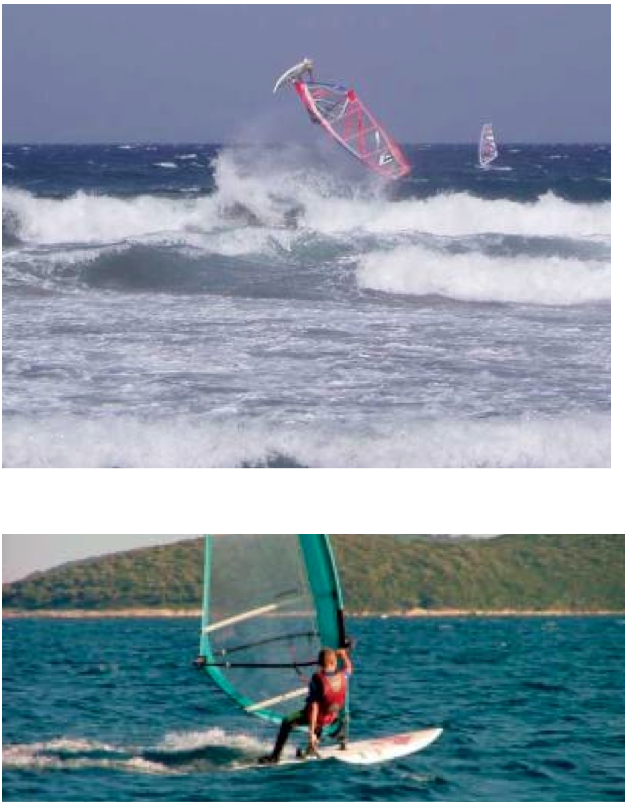
First attempts to design a vessel driven by wind but not steered by a rudder but rather by turning the sail were carried out by an American Newman Darby as early as in the late 1940s. He equipped his vessel with a joint which made it possible to connect the sail to the body in a moveable way. And it is such a flexible joint which is the technical basis of windsurfing.
In the late 1963, Newman Darby designed and constructed a testing board with a wide hull and quadrangular sail with an apex at the bottom controlled by the mast and boom. The mast and simple boom were connected in the right angle to form a cross and connected to the board with a moveable joint. In 1965, he could perform first maneuvers and he succeeded in sliding the board. He even started to manufacture and sell his product.
However, engineer Jim Drake and IT analytic Hoyle Schweitzer are considered to be the inventors of the windsurf. Both of them were surfers on breakers and their initial aim was to create a possibility to move the board independently from the waves. In 1967, Jim Drake designed a new prototype of a board with sail with a triangular sail and drop-shaped boom and most importantly with a moveable joint which controlled the sail by raking the mast and thus by changing the center of gravity of the sail. Subsequently, he had his invention patented. The patent was then bought by Hoyle Schweitzer. Right in the following year, the first windsurfing regatta was organized by Los Angeles.
Then, windsurfing started to develop quite quickly. At first in the USA, mainly in the Hawaii where there are outstanding conditions for windsurfing. The first windsurfers were usually experienced in classic surfing. Windsurfing got to Europe in 1971. In 1973, a Dutch company called Nijver – dal Ten Cate bought the license from Hoyle Schweitzer and American producers and started mass production. Just in 1976, it produced 15 thousand units called Ten Cate Windsurfing. However, the demand was still greater than the offer. At that time, large amount of materials was “homemade”.
As early as in the late 1972, there was the first competition in Europe which took place close to the Sylt Island in Germany. In 1974, the International Windsurfing Association, IWA, was founded in the USA where the first World Championship was held. In 1975, another World Championship in windsurfing took place in France; 212 competitors participated. The number of both international and local competitions was growing. They followed the rules of circuit yachting. The board for competitions was flat, nearly 4 meters long with a big fin and mainly with the ability to tack.
Fig. 62 Plan and photo of sail from 1978
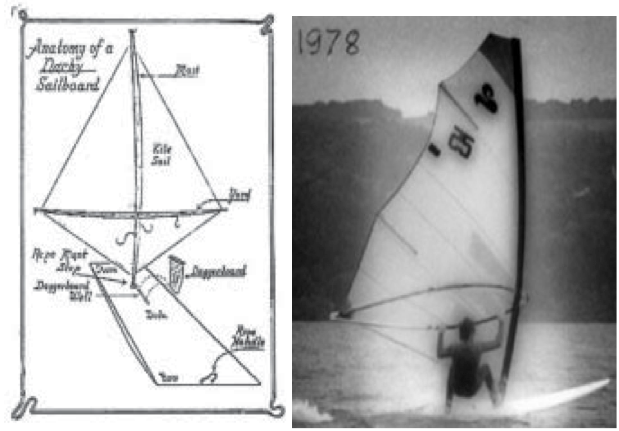
Mainly in ocean regions, windsurfers dared to sail in still stronger wind and bigger waves. There were enhancements such as storm sail, storm fin, harness, more skegs and in the end also footstraps. In the Hawaii, Mike Waltze placed a windsurfing sail on a short surf board without a fin thus designing the first special windsurf for waves and forming a new discipline called Wave. A short board was first called Sinker but later, in Europe, it started to be called Funboard. There were greater demands on suitable conditions for such boards and on their control but they were balanced with the pleasure of quick sliding and the possibility to perform a large number of maneuvers, turns and jumps. The whole range of these tricks was performed at the 1976 World Championship in the Bahamas by thirteen-year-old Robby Naish who became supposedly the most famous surfer in the history. In the following year, there was an Open Category in the World Championship. In 1982, the speed limit of 50 kph was exceeded. In 1983, World Cup professional series was first organized with Robby Naish having become the first professional World Champion. Due to great development, windsurfing has been recognized as an independent boat category by the International Yacht Racing Union (IYRU) thus opening the way to the Olympic program. It was first included in the program in 1984 in Los Angeles. However, at that time the outdated Windglider slider was approved as a monotype for the Olympics. The first Olympic winner was a Dutch, Stephan van den Berg. Even the monotype for the 1988 and 1992 Olympics, displacement Lechner board, was designed for circuits and was not suitable for strong wind. At that time, professionals in PWA raced in much more demanding conditions and different disciplines – course, slalom and mainly Wave.
In 1980s, short boards with small displacement (so-called new wave) started to be popular also in Europe. However, most European regions are far from having ideal conditions which are to be found e.g. in the Hawaii or other top regions. New types of boards were much more demanding in the area of the windsurfers’ technique, their motor abilities and mainly sufficient power of the wind. Most inland lakes, reservoirs or ponds ceased to be suitable for such new requirements. Windsurfers started to travel to places with good conditions, however, at the turn of 1980s and 1990s, the interest in windsurfing declined. It was also caused by the impossibility to produce “homemade” materials any more. In the 1996 Olympics, a new monotype was used – Raceboard Mistral One Design which remained the Olympics class until the 2004 Olympics.
Fig. 63 Sport float
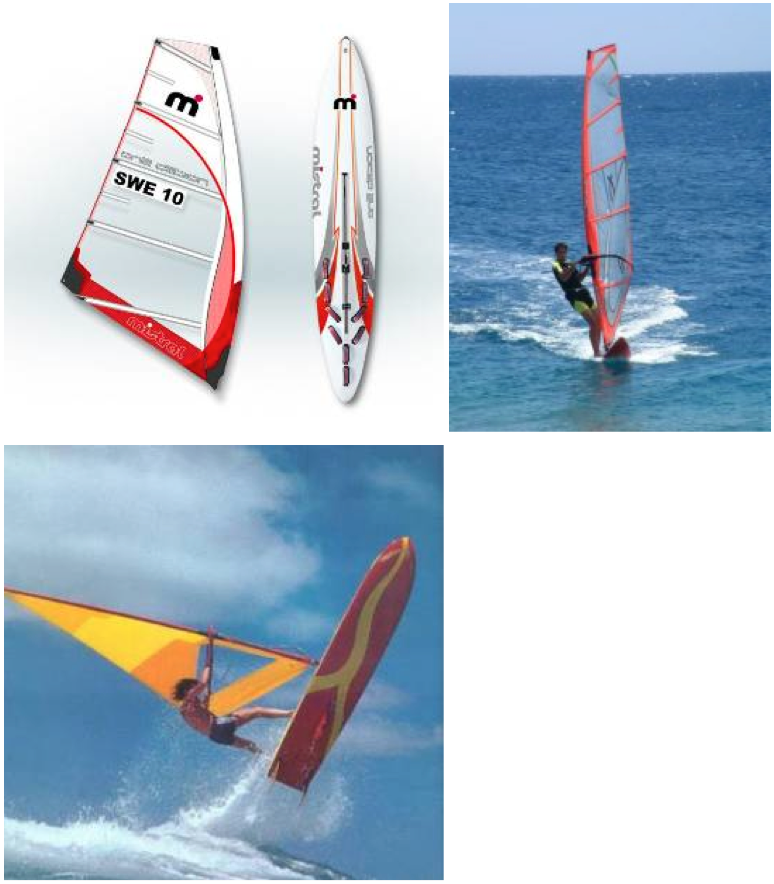
Since mid-1990s, under the pressure of material producers, windsurfing has acquired a new image, new styles and terms were spread in connection with a change in lifestyle and life philosophy. Freeriding became the most frequent and spread style, i.e. free sailing for enjoyment. A new, and much friendlier, material started to be produced for Freeriding (but not only for it). This material pushed the boundaries and broadened the possibilities for fans of windsurfing. Similarly, Freestyle became a manifestation of life philosophy. Freestyle includes some aspects similar to freestyle snowboarding.
Since 1998, WS Freestyle has made its way among competition disciplines. In 1999, a new era of short wide course boards started. Due to this, interest in this beautiful sport increased again. Earlier Course Races started to be scheduled for this new category of boards wide up to one meter with longer skegs and large and efficient sail called Formula Windsurfing. Boards of this category are able to slide thus reaching higher speed even in a relatively soft wind. A still new category which appeared in 2005, RS:X Windsurfing Class, which became the new official category for the following there Olympic Games (bottom right) has similar characteristics. However, the best professional windsurfers do not usually participate in WS.
Fig. 64 RS:X windsurfing class
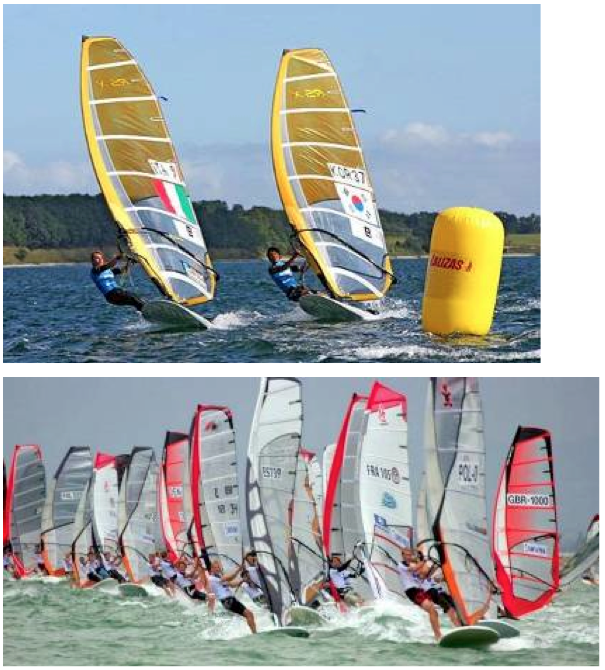
Until today, Wave has remained the most demanding discipline of windsurfing. Competitions take place only in the most demanding regions. The performance is judged subjectively by a team of referees and mainly the incredibly high jumps with difficult tricks on high breaking ocean waves reach the limit of human possibilities. Even for many outstanding surfers, windsurfing in such conditions is impossible. There are extreme requirements for equipment. The boards must be made of materials of the highest quality and their displacement is between 70 and 100 liters. They are often equipped with a higher number of short skegs. If compared with other WS disciplines, the sails are small, not very much efficient but extremely reinforced and durable. The mast is of a reduced diameter with thicker wall. Booms are short and extremely durable.
Fig. 65 Wave
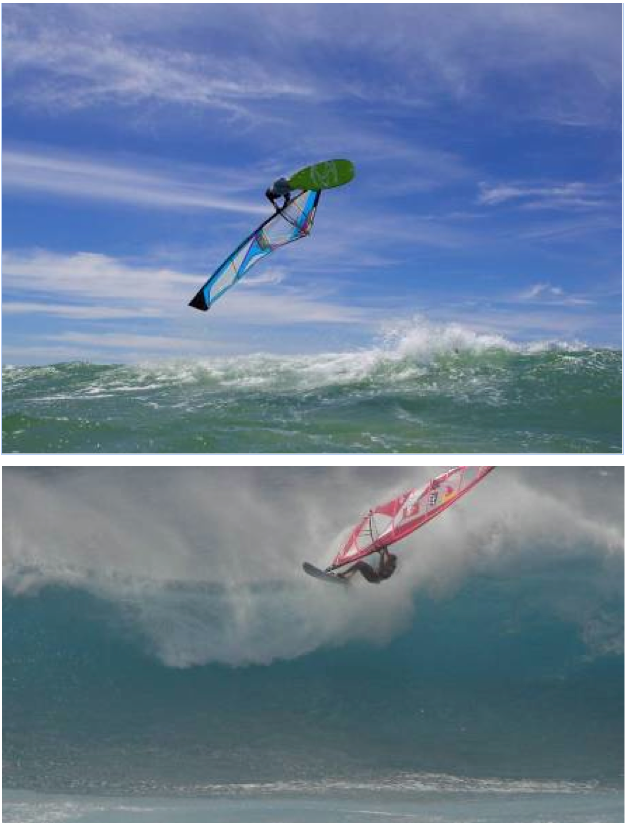
A less demanding but very popular discipline, mainly among young windsurfers, is Freestyle. It is a very popular and amusing form of competing which is sometimes more like a game. In Freestyle, windsurfers present various tricks (non-sliding), turns (sliding) and jumps on relatively small waves in quite soft wind (from approx. 8 meters per second). The performance is judged by a team of referees according to a scale which assesses the difficulty of the trick and its performance. As opposed to other WS disciplines, the race usually takes place close to the shore and there is something going on all the time. There are fewer requirements for equipment than in Wave and other professional disciplines. The boards are quite robust with displacement between 80 and 120 liters. The mast is as short and light as possible; the boom is short. The upper part of the sail is larger.
Fig. 66 Freestyle
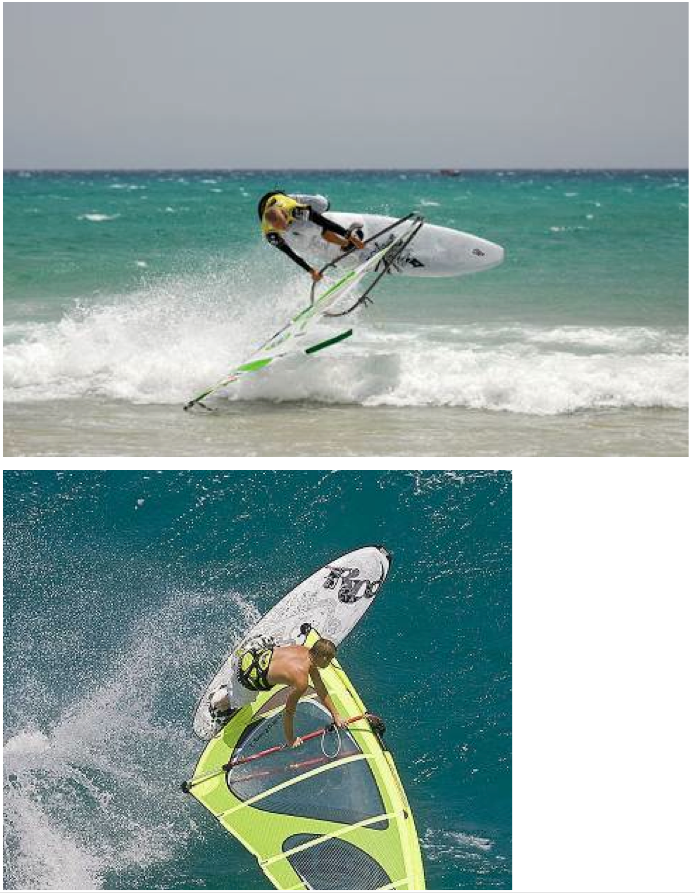
The fastest (apart from special speed races) WS discipline, which is also very popular with spectators and media, is Slalom. The race takes a number of laps on a relatively short track delineated by two buoys. The track axis is vertical to the direction of the wind. The wind is of middle intensity and the competitors choose the size of the board and the sail for individual races depending on the speed of the wind at the particular moment. Wide and short boards made of high quality materials have displacement between 80 and 130 liters (most frequently boards between 100 and 130 liters of displacement are used). The sails are of the most efficient type, which means with a deeper profile, wide track, 8 spears and 4 cambers; the size ranging from 5 to 10 sq. meters. Larger sail with respect to the given wind is usually selected than it would be required when using ordinary WS equipment. There are only fast downwind turns (jibes) and in one course, the competitors gain only what they lost during the turn. Slalom is very attractive for spectators because knockout method is used from the beginning up to the finals and the tracks are well visible from the shore. It is also attractive for many companies which produce boards as in this discipline; even professional top windsurfers have to use boards from serial production. Similarly, sails, masts and booms (always made of 100% carbon) are offered by companies. The largest sails and masts for Slalom are equal to Formula Windsurfing class.
Keywords:
Windsurfing, Jim Drake, Hoyle Schweitzer, IWA International Windsurfing Association, Freeriding, Windsurfing, RS:X windsurfing class, Wave, sail, board, displacement.